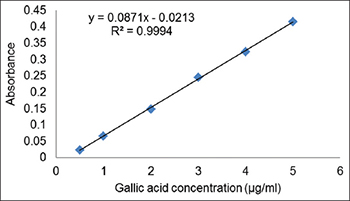Chemical composition of various Ephedra species
DOI:
https://doi.org/10.17305/bjbms.2015.539Keywords:
Ephedra, alkaloids, phenolics, flavonoids, spectrophotometry, ultra-performance liquid chromatography with ultraviolet detectionAbstract
The medicinal significance of Ephedra is based on the sympathomimetic properties of ephedrine (E) alkaloids. Pharmacological effects depend on the phytocomposition of individual Ephedra species. The aim of this study was to measure the total alkaloids content (TAC), total phenolics content (TPC), and total flavonoids content (TFC) and determine their relationship in dry herb of Ephedra major, Ephedra distachya subsp. helvetica, Ephedra monosperma, Ephedra fragilis, Ephedra foeminea, Ephedra alata, Ephedra altissima and Ephedra foliata. Nowadays, medicinal use of Ephedrae herba is limited, but the abuse of its psychostimulants is rising. In this study, TAC, TPC and TFC were determined using spectrophotometric methods. For the first time, ultra-performance liquid chromatography with ultraviolet detection (UPLC-UV) was used for separation and quantification of E-type alkaloids of various Ephedra species. The highest TPC and TFC were found in E. alata (53.3 ± 0.1 mg Gallic acid equivalents/g dry weight, 2.8 mg quercetin equivalents/g dry weight, respectively). The total content of E and pseudoephedrine determined by UPLC-UV varied between 20.8 mg/g dry weight (E. distachya subsp. helvetica) and 34.7 mg/g dry weight (E. monosperma). The variable content and ratio between secondary metabolites determined in different Ephedra species reflects their metabolic activities. Utilization of UPLC-UV unveiled that this technique is sensitive, selective, and useful for separation and quantification of different alkaloids in complex biological matrixes. The limit of detection was 5 ng. Application of UPLC-UV can be recommended in quick analyses of E-type alkaloids in forensic medicine and quality control of pharmaceutical preparations.
Citations
Downloads
References
Dewick MP. Medicinal Natural Products: A Biosynthetic Approach. 2nd ed. West Sussex, England: John Wiley and Sons; 2002. p. 383.
EFSA ANS Panel (EFSA Panel on Food Additives and Nutrient Sources), 2013. Scientific opinion on safety evaluation of Ephedra species in food. EFSA J 2013;11(11):3467, 79 pp.
Carlini EA. Plants and the central nervous system. Pharmacol Biochem Behav 2003;75(3):501-512.
Barnes J, Anderson AL, Phillipson JD. Herbal Medicines. 3rd ed. London: Pharmaceutical Press; 2007.
Abourashed EA, El-Alfy AT, Khan IA, Walker L. Ephedra in perspective – A current review. Phytother Res 2003;17(7):703-712.
Mills S, Bone K. The Essential Guide to Herbal Safety. St. Louis, MO: Elsevier Inc.; 2005.
Miyazawa M, Minamino Y, Kameoka H. Volatile components of Ephedra sinica stapf. Flavour Fragr J 1997;12(1):15-17. DOI: http://dx.doi.org/10.1002/(SICI)1099-1026(199701)12:1<15::AID-FFJ604>3.0.CO;2-5.
Tellez MR, Khan IA, Schaneberg BT, Crockett SL, Rimando AM, Kobaisy M. Steam distillation-solid-phase microextraction for the detection of Ephedra sinica in herbal preparations. J Chromatogr A 2004;1025(1):51-56.
Wang Q, Yang Y, Zhao X, Zhu B, Nan P, Zhao J, et al. Chemical variation in the essential oil of Ephedrasinica from Northeastern China. Food Chem 2006;98(1):52-58. DOI: http://dx.doi.org/10.1016/j.foodchem.2005.04.033.
Slinkard K, Singleton VL. Total phenol analyses: Automation and comparison with manual methods. Am J Enol Vitic 1977;28:49-55.
Chang CC, Yang MH, Wen HM, Chern JC. Estimation of total flavonoid content in vegetables by two complementary colorimetric methods. J Food Drug Anal 2002;10:178-82.
Gurley BJ, Wang P, Gardner SF. Ephedrine-type alkaloid content of nutritional supplements containing Ephedra sinica (Ma-huang) as determined by high performance liquid chromatography. J Pharm Sci 1998;87(12):1547-1553.
Kitani Y, Zhu S, Omote T, Tanaka K, Batkhuu J, Sanchir C, et al. Molecular analysis and chemical evaluation of Ephedra plants in Mongolia. Biol Pharm Bull 2009;32(7):1235-1243.
Caveney S, Charlet DA, Freitag H, Maier-Stolte M, Starratt AN. New observations on the secondary chemistry of world Ephedra (Ephedraceae). Am J Bot 2001;88(7):1199-1208.
Hong H, Chen HB, Yang DH, Shang MY, Wang X, Cai SQ, et al. Comparison of contents of five ephedrine alkaloids in three official origins of Ephedra herb in China by high-performance liquid chromatography. J Nat Med 2011;65(3-4):623-628. DOI: http://dx.doi.org/10.1007/s11418-011-0528-8.
Hegnauer R. Ephedraceae. In: Chemotaxonomy of plants, Vol. VII. Basel: Birkhauser Verlag; 1986. p. 546-553.
Caveney S, Starratt A. Glutamatergic signals in Ephedra. Nature 1994;372:509. DOI: http://dx.doi.org/10.1038/372509a0.
Kustrak D, Ramic A. Ephedra species and their alkaloids. Farm Glas 1994;50(12):321-336.
Freitag H, Maier-Stolte M. Ephedra L. In: Tutin TG, editor. Flora Europaea. Vol I. Cambridge: University Press; 1993.
Harisaranraj R, Suresh K, Saravanababu S. Evaluation of the chemical composition Raufolwia serpentina and Ephedra vulgaris. Adv Bio Res 2009;3(5-6):174-178.
Cottiglia F, Bonsignore L, Casu L, Deidda D, Pompei R, Casu M, et al. Phenolic constituents from Ephedra nebrodensis. Nat Prod Res 2005;19(2):117-23.
Amakura Y, Yoshimura M, Yamakami S, Yoshida T, Wakana D, Hyuga M, et al. Characterization of phenolic constituents from Ephedra herb extract. Molecules 2013;18(5):5326-5334. DOI: http://dx.doi.org/10.3390/molecules18055326.

Downloads
Additional Files
Published
Issue
Section
Categories
How to Cite
Accepted 2015-06-11
Published 2015-07-18









